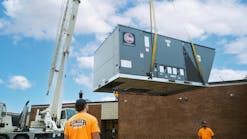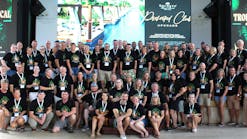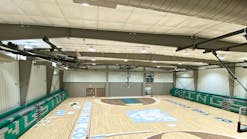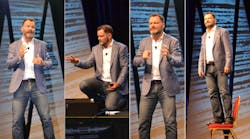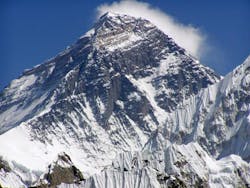Climb Every Mountain: At MSCA, Jamie Clarke Recounts Conquering Mt. Everest
Somewhere in your future, there's a summit. When you find it, climb it. To borrow a phrase, just do it.
That was world-renowned adventurer Jamie Clarke's message to hundreds of attendees at the 2015 MSCA Annual Conference, "The View from Above."
It was apt that MSCA booked Clarke for a conference with a theme of climbing higher and soaring to greater heights. His presentation was filled with images of the great mountain and the danger that faced the teams during three expeditions to reach the summit.
He finally reached the top, on his third attempt, on May 23, 1997. But getting there took almost 10 years, and two failed expeditions before that.
Clarke said when growing up, he never imagined himself an adventurer. He viewed with disdain the outdoor books his mom got him for Christmas. But when he got the bug to climb, it never left him. He finagled his way into a supporting role on the "Climb for Hope" expedition in 1991. Bad weather stopped the team at 25,000 feet. The second attempt came in 1994, with the "Lungs Without Limits" expedition, which was halted with a mere 500 feet to go, due to altitude sickness and bad weather.
He finally reached the summit on May 23, 1997.
Through all the attempts, a very animated, humorous and entertaining Clarke said there were many personal and professional challenges that had to be overcome. But he couldn't have asked for a better series of life lessons.
After the failed first expedition, Clarke refused to let himself and the team be defined by the failure, as some in the media wanted to do.
"On the one hand I felt there was this great experience and triumph, and on the other, a great disaster," Clarke said. "I began to wonder what success is. I felt great about what we did. We can’t be defined entirely by "the summit."
"I could feel the pressures of society bombarding me about the definition of success. I learned that I would be measured by the thickness of my wallet, and cars, and suits, but that wasn’t what I thought success was about."
Clarke knew he had to return to Everest. "I had to forge the character I lacked," he said. "Because lessons can’t be found in books. You gotta get up there in the rarified air, for the perspective you get when you have some separation. Then, you can move forward in a new way with a new focus. Then, you can look back and get context and understanding. It’s a romantic, navel-gazing path, but it can be beneficial if you don’t pursue it as a sole means of escape, if you use it to go toward knowledge, not run away from reality."
"When I first came upon it, I was shocked. Such a big place in my mind and my heart, how could it manifest itself so small? The very top is no bigger than those chairs you're sitting in."
After giving his Sherpa guides the first embrace of the peak, Clarke took his turn. "I put one foot in Tibet and one foot in Nepal. I looked down 8000 feet (on the south side), and stood there. It was mid-morning. I could see stars above, and the curvature of the earth. I realized, for the first time in my life, there was no more 'up,' no more struggle. There was no fist pump, only peace, to which I surrendered."
Then came his challenge and encouragement to MSCA conference attendees: "How will you forge new terrain for yourself, and carve a different way integrating technology, innovation, ideas and new services? This is the wonderful challenge: knowing where you’ve come from but not letting that dictate where you will go. Having that understanding: that’s what distance, elevation, and altitude give us: perspective.
"I have to believe somehow, somewhere, your summit awaits. Many of you have already been to one. But there is another. I wish you the courage and the passion to do it."
Clarke's exploits include covering The Empty Quarter of Arabia by camel. He has co-authored The Power of Passion, and From Everest to Arabia: the Making of an Adventursome Life. His business, Live Out There.com is an online outdoor apparel store that serves all of Canada online.






